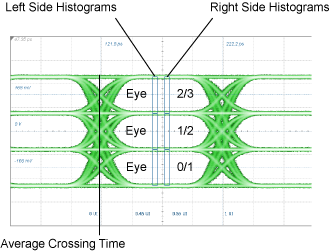:MEASure:EYE:PEECq
Command Syntax
:MEASure:EYE:PEECq
Query Syntax
:MEASure:EYE:PEECq?
Description
 Starts a Partial EECQ (Electrical Eye Closure Quaternary) measurement which is an electrical version of the TDECQ measurement (:MEASure:EYE:TDEQ). Because EECQ is an electrical measurement, its value is double the TDECQ measurement as the math is 20 log10 instead of 10 log10. There are six possible Partial EECQ measurements on a particular waveform as explained below. Use the :MEASure:EYE:PEECq:SOURce command to select the source waveform for the measurement.
Starts a Partial EECQ (Electrical Eye Closure Quaternary) measurement which is an electrical version of the TDECQ measurement (:MEASure:EYE:TDEQ). Because EECQ is an electrical measurement, its value is double the TDECQ measurement as the math is 20 log10 instead of 10 log10. There are six possible Partial EECQ measurements on a particular waveform as explained below. Use the :MEASure:EYE:PEECq:SOURce command to select the source waveform for the measurement.
The source waveform for the Partial EECQ measurement is meant to be the output of the Reference Receiver waveform signal processing operator (:FUNCtion1:FOPerator RRX). However, you can select any valid, available source waveform. Refer to the Example Command Sequence in this topic to learn how to configure the Reference Receiver operator for this measurement.
Sending this command starts a single measurement on Eye 0, Eye 1, or Eye 2 that is based on either the left or right histogram as shown in the following figure. The example command sequence in this topic shows how the command is sent six times to start all of six possible Partial EECQ measurements on a particular waveform. This differs from the standardEECQ measurement (:MEASure:EYE:EECQ) where a single measurement is performed that includes the contribution of all three eyes. By comparing the individual EECQ contribution of each eye, the Partial EECQ measurements can provide additional insights into the causes of measurement problems.
Send the :MEASure:EYE:PEECq:EYE command to select the eye on which to perform the measurement. Send the :MEASure:EYE:PEECq:SIDe command to select either the left or right histogram for the measurement.
The location of a measurement's histograms is annotated on the displayed waveform. Like the standard EECQ measurement, these two vertical histograms are located at 0.45 UI and 0.55 UI from the waveform's average crossing time as is shown in the following figure.

This measurement requires pattern lock (:TRIGger:PLOCk).
Measurement Identification
Avoid subtle programming errors! To ensure that the correct measurement is installed or queried, always explicitly identify a measurement when installing a measurement or querying a measured value, status, or detail. To identify a measurement, specify the measurement's source waveform (:SOURce child command). With some measurements, you may also need to specify other identifying values. Generally, when selecting a measurement using FlexDCA's GUI, if a dialog appears prompting you to select values, you should explicitly specify these values when remotely identifying the measurement. More information.
For example, to return the status of the measurement, :MEASure:EYE:PEECq:
flex.write(':MEASure:EYE:PEECq:SOURce CHAN1A')
if flex.query(':MEASure:EYE:PEECq:STATus?') == 'CORR';
measurement = flex.query(':MEASure:EYE:PEECq?')
else:
details = flex.query(':MEASure:EYE:PEECq:STATus:DETails?')
reason = flex.query(':MEASure:EYE:PEECq:STATus:REASon?')
Measurement Ready?
To confirm that the measurement is ready to read, you can query the measurement's status:
if ('CORR' in Flex.query(':MEASure:EYE:PEECq:STATus?')):
measurement = Flex.query(':MEASure:EYE:PEECq?')
If averaging is turned on (:ACQuire:AVERaging), you can also confirm if the measurement result is ready by comparing the number of specified averages (:ACQuire:ECOunt?) versus the number of measurement sweeps that have occurred (:MEASure:EYE:PEECq:COUNt?). The technique uses the :COUNt? common measurement query. For example,
if (Flex.query(':MEASure:EYE:PEECq:COUNt?') >= Flex.query(':ACQuire:ECOUNt?')):
measurement = Flex.query(':MEASure:EYE:PEECq?')
You can also use an acquisition limit lest to test that a number of waveform samples, or pattern acquisitions have completed before returning a measurement. Refer to the :LTESt:ACQuire:CTYPe command.
Common Measurement Child Queries
This command supports the use of the following common measurement queries: :LOCation?, :COUNt?, :MAXimum?, :MINimum?, :MEAN?, and :SDEViation?.
Requires FlexDCA revision A.07.90 and above.
Example Command Sequence
:SYSTem:MODE EYE :SYSTem:AUToscale;*OPC? :TRIGger:PLOCk ON :FUNCtion1:FOPerator RRX :FUNCtion1:OPERand1 CHAN1A :SPRocess1:RRX:PRESets "CEI-112G-Linear TP1a (53GBd)" :FUNCtion1:COLor TCOLor4 :FUNCtion1:DISPlay ON :MEASure:EYE:PEECq:SOURce1 FUNCtion1 :MEASure:EYE:PEECq:EYE EYE0 :MEASure:EYE:PEECq:SIDe RIGHt :MEASure:EYE:PEECq :MEASure:EYE:PEECq:SIDe LEFT :MEASure:EYE:PEECq :MEASure:EYE:PEECq:EYE EYE1 :MEASure:EYE:PEECq:SIDe RIGHt :MEASure:EYE:PEECq :MEASure:EYE:PEECq:SIDe LEFT :MEASure:EYE:PEECq :MEASure:EYE:PEECq:EYE EYE2 :MEASure:EYE:PEECq:SIDe RIGHt :MEASure:EYE:PEECq :MEASure:EYE:PEECq:SIDe LEFT :MEASure:EYE:PEECq